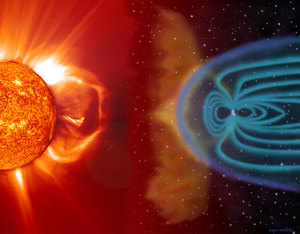
 A gigantic spot, large enough to swallow the Earth in one gulp, slides into view on the edge of the Sun’s surface. It creeps over a period of days across the Sun’s visible disk, growing ominously. As it nears the Sun’s center a massive solar flare erupts from the spot, triggering a coronal mass ejection that hurls billions of tons of hot plasma directly at our planet! Is this the end of life on Earth? What can save us from being baked like cookies?
A gigantic spot, large enough to swallow the Earth in one gulp, slides into view on the edge of the Sun’s surface. It creeps over a period of days across the Sun’s visible disk, growing ominously. As it nears the Sun’s center a massive solar flare erupts from the spot, triggering a coronal mass ejection that hurls billions of tons of hot plasma directly at our planet! Is this the end of life on Earth? What can save us from being baked like cookies?
Actually, this scenario has played out countless times in the Earth’s history. The reason we’re not all just crispy spots on the ground is that the Earth has a powerful magnetic field that deflects the solar plasma toward the North and South Poles. The only visible effect of this process is the aurora, which occurs when the energetic plasma strikes the atmosphere. But it’s possible, with a little know-how and some easy to find materials, to see the effect solar plasma has on our protective magnetic field.
As part of its public education efforts NASA has developed a series of simple classroom experiments that illustrate a number of principles from planetary and space science. This article, A Soda Bottle Magnetometer, describes how to make a device to measure how much the Earth’s magnetic field flexes when it’s struck by a coronal mass ejection. The magnetometer is essentially a very sensitive magnetic compass, and it’s quite easy to build. It’s also an easy project to "set it and forget it." You can set one up in a quiet corner and look at it occasionally; if the kids notice some activity you can take them to the NOAA Estimated 3-hour Planetary Kp-Index Web page to see if the professionals have seen the same magnetic activity. Strong fluctuations in Earth’s magnetic field can indicate aurora activity, too. If you see a large change in the magnetic field in the evening, give a look to the sky outside. You may be rewarded with some visible aurora.
Sunspot activity should pick up over the next five years or so, since a new 11-year sunspot cycle has just begun. So keep this little project in mind to show the kids that it’s possible to see the invisible if you know how to look.

